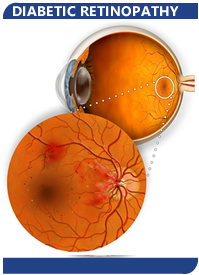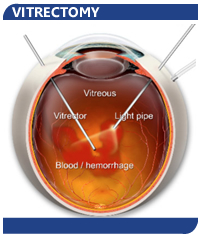Diabetic Retinopathy
If you have diabetes mellitus, your body does not use and store sugar properly. Diabetes can cause high blood-sugar levels, excessive thirst and urination. It can also cause changes in the body's blood vessels, veins, and arteries that carry blood throughout your body.
Because diabetes affects your body in these ways, it can affect vision by causing cataracts, glaucoma, and, most importantly, damage to blood vessels inside the eye.
What is diabetic retinopathy?
 Diabetic retinopathy is a complication of diabetes that is caused by changes in the blood vessels of the eye. The retina is a nerve layer at the back of the eye that senses light and helps to send images to your brain. Diabetic retinopathy is a complication of diabetes that is caused by changes in the blood vessels of the eye. The retina is a nerve layer at the back of the eye that senses light and helps to send images to your brain.
When blood vessels in the retina are damaged, they may leak fluid or blood, and grow fragile, brush-like branches and scar tissue. This can blur or distort the images that the retina sends to the brain.
Diabetic retinopathy is the leading cause of new blindness among adults in the United States. People with untreated diabetes are said to be 25 times more at risk for blindness than the general population.
The longer a person has diabetes, the more the risk of developing diabetic retinopathy increases. About 80% of the people who have had diabetes for at least 15 years have some blood vessel damage to their retina. People with Type I, or juvenile, diabetes are more likely to develop diabetic retinopathy at a younger age.
If you have diabetes, it's important to know that today, with improved methods of diagnosis and treatment, only a small percentage of people who develop retinopathy have serious vision problems.
Types of diabetic retinopathy
Background retinopathy is an early stage of diabetic retinopathy. In this stage, tiny blood vessels within the retina become damaged and leak blood or fluid. Leaking fluid causes the retina to sell or to form deposits called exudates.
While this stage usually doesn't affect your vision, it can lead to more sight-threatening stages. For this reason, background retinopathy is considered a warning sign.
Sometimes the leaking fluid collects in the macula, the part of the retina that lets us see fine details, like letters or numbers. This problem in called macular edema. Reading and close work may become more difficult because of the condition.
Proliferative retinopathy describes the changes that occur when new, abnormal blood vessels begin growing on the surface of the retina.
The abnormal growth is called neovascularization. These new blood vessels have weaker walls and may break and bleed. The vitreous is the clear, jelly-like substance that fills the center of the eye. Leaking blood can cloud the vitreous and partially block the light passing through the pupil towards the retina, causing blurred and distorted images.
These abnormal blood vessels may grow scar tissue that can pull the retina away from the back o the eye. This is called a retinal detachment. If left untreated, a retinal detachment can cause severe vision loss.
Abnormal blood vessels may also grow around the pupil (on the iris) causing glaucoma by increasing pressure within the eye.
Proliferative diabetic retinopathy is the most serious form of diabetic retinal disease. It affects up to 20% of diabetics and can cause sever loss of sight, including blindness.
Symptoms
There are usually no symptoms of background retinopathy, although gradual blurring of vision may occur if macular edema is present. You may never notice changes in your vision. A medical examination is the only way to find changes inside your eye.
When bleeding occurs, your sight may become hazy, spotty or even disappear altogether. While there is no pain, proliferative retinopathy is a severe form of the disease and requires immediate medical attention. Pregnancy and high blood pressure may aggravate diabetic retinopathy.
Diagnosis
The best protection against diabetic retinopathy is to have regular medical eye examinations by your ophthalmologist (medical eye doctor). Serious retinopathy can be present without any symptoms. The disease can improve with treatment.
To find diabetic retinopathy, the ophthalmologist looks at the inside of the eye using an instrument called an ophthalmoscope. The pupils may need to be dilated (enlarged) with eye drops.
If your ophthalmologist finds diabetic retinopathy, he or she may order color photographs of the retina or a special test called fluorescein angiography to find out if you need treatment. Fluorescein angiography is a test where dye is injected in your arm and special photos of your eye are taken.
Treatment
Your ophthalmologist will consider:
- Your age
- Your medical history
- Your lifestyle
- How much your retina is damaged
In many cases treatment is not necessary, but you will need to continue having regular eye exams. In other cases, treatment is recommended to stop the damage of diabetic retinopathy and improve sight whenever possible.
Laser Surgery
This procedure is often helpful in treating diabetic retinopathy. A powerful beam of laser light is focused on the damaged retina. Small bursts of the laser's beam seal leaking retinal vessels to reduce macular edema. This is called photocoagulation.
For abnormal blood vessel growth (neovascularization), the laser beam bursts are scattered throughout the side areas of the retina. The small laser scars reduce the abnormal blood vessel growth and help bond the retina to the back of the eye, preventing retinal detachment.
Laser surgery may be performed in your ophthalmologist's office or an outpatient clinic. If diabetic retinopathy is detected early, laser surgery slows down vision loss. Even in the more advanced stages of the disease (proliferative retinopathy), it reduces the change of severe visual impairment.
Cryotherapy
If the vitreous is clouded by blood, laser surgery cannot be used until the blood settles or clears. In some cases of bleeding into the vitreous, cryotherapy, or freezing, of the retina may help shrink the abnormal blood vessels.
Vitrectomy
 In advanced proliferative diabetic retinopathy, the ophthalmologist may recommend a vitrectomy. This microsurgical procedure is performed in the operating room. Vitrectomy removes the blood-filled vitreous and replaces it with a clear solution. In advanced proliferative diabetic retinopathy, the ophthalmologist may recommend a vitrectomy. This microsurgical procedure is performed in the operating room. Vitrectomy removes the blood-filled vitreous and replaces it with a clear solution.
About 70% of vitrectomy patients notice an improvement in sight after surgery. Sometimes the ophthalmologist may wait from several months up to a year to see if the blood clears on its own, before going ahead with a vitrectomy.
Retinal Repair
If scar tissue detaches the retina from the back of the eye, severe sight loss or blindness can result unless surgery is performed to reattach the retina.
What is your part in treatment?
Successful care of diabetic retinopathy depends on more than early treatment by your ophthalmologist. Your attitude and attention to medications and diet are essential. You must maintain blood sugar levels, avoid smoking and watch your blood pressure.
Physical activity is usually no problem for people with background retinopathy. Occasionally, people with active proliferative retinopathy are advised to restrict physical activity.
Vision loss is largely preventable
-
Diabetic retinopathy may be present without any symptoms
-
Early detection of diabetic retinopathy is the best protection against loss of vision
-
People with diabetes should schedule examinations by an ophthalmologist at least once a year. More frequent medical eye examinations may be necessary once diabetic retinopathy has been diagnosed.
-
With careful monitoring, the ophthalmologist can begin treatment before sight is affected. Laser and operative surgery are highly effective treatment for diabetic retinopathy.
|





